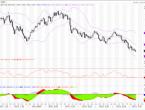Gold market analysis: gold continues to fluctuate in a narrow range at a low level
On Tuesday (October 12), the U.S. stock market and 10-year Treasury bond yields fell to stimulate demand for hedging. Investors returned to safe havens for the U.S. dollar and precious metals, and gold rose slightly to the 1,760 level. However, the overall performance of gold continued the recent extreme narrow-range consolidation trend.
The IMF released the October "World Economic Outlook" to revise the global economic growth forecast from 6.0% to 5.9%. The IMF calls on the Federal Reserve and other central banks to be prepared to act quickly to prevent inflation from getting out of control. The IMF expects that there is a "dangerous divergence" in the current market, and it will lower the US GDP forecast for this year to 6% and increase it to 5.2% next year; it will lower its forecast for China's GDP this year to 8% and 5.6% next year. Atlanta Fed President Raphael Bostic pointed out that the US inflation spike has lasted longer than expected, and high inflation should no longer be considered temporary. Vice Chairman Clarida (Richard Clarida) said that with substantial progress in inflation and employment tasks, the Fed has almost met the conditions for starting the tapering of debt purchases (Taper). Also in the United States, the House of Representatives voted on a short-term increase in the government debt ceiling proposal on Tuesday to prevent the first catastrophic default of US debt. ABN AMRO senior precious metals strategist Georgette Boele reported that the price of gold has fallen by 7.5% this year, and the future price outlook is still negative because the price of gold has not been able to recover the $1,800 per ounce price. The report commented that since June, the price of gold has maintained a downward trend, mainly due to the strength of the U.S. dollar and the rise in U.S. bond yields. Recently, oil prices hit a seven-year high and increased inflationary concerns. The market has also begun to reflect the possibility that the Fed may raise interest rates earlier than expected, putting further pressure on gold prices. Last week, the U.S. 10-year Treasury bond yield hit a four-month high, and the dollar index has risen by 5% this year. The report believes that the outlook for the gold price in the fourth quarter and 2022 is relatively negative, mainly due to the strong performance of the U.S. dollar and the impact of the global monetary policy environment will gradually tighten, which usually means higher yields of national debt and the price of gold The fall.
From a technical perspective of gold, despite the recent decline, gold continues to trade within the range of $1750-70 for the past two weeks. Only the daily closing outside the channel can trigger a decisive trend. At the same time, the relative strength index on the 4-hour chart continues to fluctuate between 40 and 60, indicating that it is difficult for gold to find a single direction in the near future. If the price of gold falls below US$1750, US$1735 may be used as the next downside target, followed by US$1725, and the more critical lower support is at 1680. On the other hand, the 200-period moving average has formed an important resistance level at 1780 USD. If it can break through, there is a chance to test the 1800 mental mark.
Bank of China Guangdong Branch Wang Gang
Original title: 20211013—Gold continues to oscillate in a narrow range at a low level
Source: Bank of China official website












